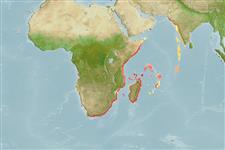Environment: milieu / climate zone / depth range / distribution range
Écologie
marin; eau douce; saumâtre démersal; catadrome (Ref. 51243). Tropical; 25°N - 35°S
Western Indian Ocean: east coast rivers of Africa from Kenya south to Cape Agulhas, also in Madagascar and other western Indian Ocean islands (Ref. 7248, 52193). Reported from New Caledonia (Ref. 11889).
Taille / Poids / Âge
Maturity: Lm ? range ? - ? cm
Max length : 150 cm TL mâle / non sexé; (Ref. 3506); 120.0 cm SL (female); poids max. publié: 5.7 kg (Ref. 52193); poids max. publié: 5.7 kg; âge max. reporté: 20 années (Ref. 48660)
Épines dorsales (Total): 0; Épines anales 0.
Migratory species, which breeds in the ocean (Ref. 52331). Inhabits both quiet and fast flowing water (Ref. 13337). Elvers ascend rivers mainly at night and overcome waterfalls and walls of dams with great determination. Adults usually sedentary. Females can attain 120 cm SL and are generally longer and heavier than males (Ref. 48660). Carnivorous, eats dead or living prey but especially fish and crabs. After feeding in fresh water for ten years or more, adults assume a silver breeding dress, the eyes become enlarged and they return to sea to breed. Considered to breed east of Madagascar, but thought to move south of that island on its way to the Mozambique coast and South African rivers (Ref. 13337). Flesh fatty but highly esteemed as smoked or jellied eel (Ref. 5214). Caught with various types of nets (Ref. 4967).
Life cycle and mating behavior
Maturité | Reproduction | Frai | Œufs | Fécondité | Larves
Castle, P.H.J., 1984. Anguillidae. p. 34-37. In J. Daget, J.-P. Gosse and D.F.E. Thys van den Audenaerde (eds.) Check-list of the freshwater fishes of Africa (CLOFFA). ORSTOM, Paris and MRAC, Tervuren. Vol. 1. (Ref. 3506)
Statut dans la liste rouge de l'IUCN (Ref. 130435)
Menace pour l'homme
Harmless
Utilisations par l'homme
Pêcheries: commercial; Aquaculture: commercial; pêche sportive: oui
Plus d'informations
Noms communsSynonymesMétabolismePrédateursÉcotoxicologieReproductionMaturitéFraiRassemblement de ponteFéconditéŒufsDéveloppement de l'œuf
RéférencesAquacultureProfil d'aquacultureSouchesGénétiqueElectrophoresesHéritabilitéPathologiesTraitementNutrientsMass conversion
Outils
Articles particuliers
Télécharger en XML
Sources Internet
Estimates based on models
Preferred temperature (Ref.
123201): 19.6 - 27.5, mean 26.4 °C (based on 98 cells).
Phylogenetic diversity index (Ref.
82804): PD
50 = 0.5000 [Uniqueness, from 0.5 = low to 2.0 = high].
Bayesian length-weight: a=0.00089 (0.00051 - 0.00156), b=3.20 (3.05 - 3.35), in cm total length, based on LWR estimates for this species & Genus-body shape (Ref.
93245).
Niveau trophique (Ref.
69278): 3.3 ±0.55 se; based on food items.
Generation time: 26.8 ( na - na) years. Estimated as median ln(3)/K based on 1
growth studies.
Résilience (Ref.
120179): Très faible, temps minimum de doublement de population supérieur à 14 ans (K=0.04).
Fishing Vulnerability (Ref.
59153): Very high vulnerability (81 of 100).
